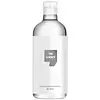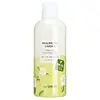What's inside
What's inside
 Key Ingredients
Key Ingredients

No key ingredients
 Benefits
Benefits

 Concerns
Concerns

 Ingredients Side-by-side
Ingredients Side-by-side

Water
Skin ConditioningPEG-6 Caprylic/Capric Glycerides
EmulsifyingDipropylene Glycol
HumectantPEG-7 Glyceryl Cocoate
EmulsifyingPhenoxyethanol
PreservativeEthylhexylglycerin
Skin ConditioningDisodium EDTA
Butylene Glycol
HumectantCineole
Skin ProtectingCentella Asiatica Extract
Cleansing(Licorice/Reynoutria Japonica) Root/Stem Extract
AntioxidantGold
Cosmetic ColorantCamellia Sinensis Leaf Extract
AntimicrobialGlycyrrhiza Glabra Root Extract
BleachingChamomilla Recutita Extract
Skin ConditioningRosmarinus Officinalis Leaf Extract
AntimicrobialLavandula Angustifolia Flower Extract
CleansingWater, PEG-6 Caprylic/Capric Glycerides, Dipropylene Glycol, PEG-7 Glyceryl Cocoate, Phenoxyethanol, Ethylhexylglycerin, Disodium EDTA, Butylene Glycol, Cineole, Centella Asiatica Extract, (Licorice/Reynoutria Japonica) Root/Stem Extract, Gold, Camellia Sinensis Leaf Extract, Glycyrrhiza Glabra Root Extract, Chamomilla Recutita Extract, Rosmarinus Officinalis Leaf Extract, Lavandula Angustifolia Flower Extract
Water
Skin ConditioningDipropylene Glycol
HumectantPEG-7 Caprylic/Capric Glycerides
EmulsifyingPEG-7 Glyceryl Cocoate
EmulsifyingCamellia Sinensis Leaf Water
MaskingButylene Glycol
HumectantOpuntia Coccinellifera Fruit Extract
Skin ConditioningCitrus Unshiu Peel Extract
MaskingLavandula Angustifolia Extract
Skin ConditioningJasminum Officinale Extract
MaskingRosmarinus Officinalis Leaf Extract
AntimicrobialSciadopitys Verticillata Root Extract
AntimicrobialHovenia Dulcis Fruit Extract
Skin ConditioningPortulaca Oleracea Extract
Skin ConditioningPhenoxyethanol
PreservativeEthylhexylglycerin
Skin Conditioning1,2-Hexanediol
Skin ConditioningCaprylyl Glycol
EmollientSodium Citrate
BufferingCitric Acid
BufferingDisodium EDTA
Water, Dipropylene Glycol, PEG-7 Caprylic/Capric Glycerides, PEG-7 Glyceryl Cocoate, Camellia Sinensis Leaf Water, Butylene Glycol, Opuntia Coccinellifera Fruit Extract, Citrus Unshiu Peel Extract, Lavandula Angustifolia Extract, Jasminum Officinale Extract, Rosmarinus Officinalis Leaf Extract, Sciadopitys Verticillata Root Extract, Hovenia Dulcis Fruit Extract, Portulaca Oleracea Extract, Phenoxyethanol, Ethylhexylglycerin, 1,2-Hexanediol, Caprylyl Glycol, Sodium Citrate, Citric Acid, Disodium EDTA
 Reviews
Reviews

Ingredients Explained
These ingredients are found in both products.
Ingredients higher up in an ingredient list are typically present in a larger amount.
Butylene Glycol (or BG) is used within cosmetic products for a few different reasons:
Overall, Butylene Glycol is a safe and well-rounded ingredient that works well with other ingredients.
Though this ingredient works well with most skin types, some people with sensitive skin may experience a reaction such as allergic rashes, closed comedones, or itchiness.
Learn more about Butylene GlycolDipropylene Glycol is a synthetically created humectant, stabilizer, and solvent.
This ingredient helps:
Dipropylene glycol is technically an alcohol, but it belongs to the glycol family (often considered part of the ‘good’ alcohols). This means it is hydrating and gentle on skin unlike drying solvent alcohols like denatured alcohol.
As a masking agent, Dipropylene Glycol can be used to cover the smell of other ingredients. However, it does not have a scent.
Studies show Dipropylene Glycol is considered safe to use in skincare.
Learn more about Dipropylene GlycolDisodium EDTA plays a role in making products more stable by aiding other preservatives.
It is a chelating agent, meaning it neutralizes metal ions that may be found in a product.
Disodium EDTA is a salt of edetic acid and is found to be safe in cosmetic ingredients.
Learn more about Disodium EDTAEthylhexylglycerin (we can't pronounce this either) is commonly used as a preservative and skin softener. It is derived from glyceryl.
You might see Ethylhexylglycerin often paired with other preservatives such as phenoxyethanol. Ethylhexylglycerin has been found to increase the effectiveness of these other preservatives.
Peg-7 Glyceryl Cocoate is created from polyethylene glycol and fatty acids from coconut oil.
It is a synthetic polymer with emulsifying and cleansing properties.
As an emulsifier, Peg-7 Glyceryl Cocoate prevents ingredients such as oils and water from separating. It also helps rinse away oils, dirt, and pollutants from skin.
Peg-7 Glyceryl Cocoate may not be fungal acne safe. It can also dry out skin.
Learn more about PEG-7 Glyceryl CocoatePhenoxyethanol is a preservative that has germicide, antimicrobial, and aromatic properties. Studies show that phenoxyethanol can prevent microbial growth. By itself, it has a scent that is similar to that of a rose.
It's often used in formulations along with Caprylyl Glycol to preserve the shelf life of products.
Rosmarinus Officinalis Leaf Extract comes from rosemary. Rosemary is native to the Mediterranean.
While Rosmarinus Officinalis Leaf Oil can be volatile due to its fragrant properties, the fragrance components are usually removed in the leaf extract.
Rosemary Leaf Extract contains many antioxidants such as rosmarinic acid and caffeic acid. Rosemarinic acid, a compound found in rosemary leaf, has been found to help soothe skin conditions such as eczema and acne.
Learn more about Rosmarinus Officinalis Leaf ExtractWater. It's the most common cosmetic ingredient of all. You'll usually see it at the top of ingredient lists, meaning that it makes up the largest part of the product.
So why is it so popular? Water most often acts as a solvent - this means that it helps dissolve other ingredients into the formulation.
You'll also recognize water as that liquid we all need to stay alive. If you see this, drink a glass of water. Stay hydrated!
Learn more about Water